Silver and Death
There is a dusty treeless hill in Bolivia south of the equator called Cerro Rico (rich hill), a lifeless hump of  land five thousand miles from Spain.
land five thousand miles from Spain.
In 1544 a peasant happened upon some shiny ore on the side of the hill and showed it to his friends who agreed it was silver. Delighted but not surprised, the first claim was quietly dug by those few men in this remote desert town oblivious to the strong-armed grasp of the encroaching and voracious European conquistadors.
But the secret was not to be kept. The invading Spaniards soon heard of this place called Potosi, a sleepy riverside town of a few hundred farmers and lama herders. First the soldiers then the bureaucrats, entrepreneurs, merchants and slave traders invaded Potosi.
The following year a large scale mining operation was pressed into service; a ghastly fuming smelter was built, small caves were pick-axed into kilometers-long caverns, human and animal trains hauled burdens of rich ore (zinc and tin are also present) from the bowels of the mountain. Much of the derived wealth was destined for the opulent and excessive monarchy in Madrid.
Wealth and Poverty
Potosi became the richest silver mine in the world at that time. The town exploded by 1650 to one of the largest cities in the world with a strict hierarchy of social and  economic status. After the crown received its 20%, wealthy land owners and managers built elegant mansions as merchants set up shop to provide goods and services.
economic status. After the crown received its 20%, wealthy land owners and managers built elegant mansions as merchants set up shop to provide goods and services.
Still visible today are s few elegant facades along the main streets as well as soaring steeples and domes of Potosi’s Catholic churches. The famously ornate Baroque portal to St Lorenzo’s church, carved by impoverished native artisans in the 16th century, is the epitome of this harsh discrepancy between the rich and poor.
At the bottom of the system were the peasant native Indians who quickly ran out of health and ability to work the mines. By the arrival of the 17th century the Spanish barons and mine owners were importing countless slaves from Africa to replace the sick and dead natives.
Life was unspeakably wretched for these conscripts. All Indians and slaves over the age of 18 had to work twelve-hour shifts. Younger 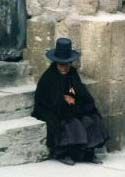 able children worked less but were subject to the same dangerous conditions of poisonous gasses, backbreaking digging, deadly cave-ins, life without light for weeks on end (miners would live underground even when they were off shift).
able children worked less but were subject to the same dangerous conditions of poisonous gasses, backbreaking digging, deadly cave-ins, life without light for weeks on end (miners would live underground even when they were off shift).
In the toxic smelter, workers’ lives fell short from breathing the mercury vapors. The finished metal was then carried by lama train down (Potosi, at over 13,000 feet elevation is the world’s highest city) to the west coast (now Chile) where Spanish galleons carried it off to feed the appetites of an excessive royal court–but not before greedy sea pirates from other European countries succeeded in absconding with some of the booty.
Like all great empires that have risen and faded before and since Potosi, the major toll of this vast enterprise was paid in human suffering and death that underlay the three hundred years of draining the mountain. “It has been estimated that over the three centuries of the colonial period–1545 to 1825–as many as eight million Africans and Indians died from the appalling conditions in the Potosi mines.,” reported one account.
To see for ourselves this harrowing haunt of history, we followed our guide into the black hole of one of mines. Before entering the cave our guide wrapped us in a heavy raincoat, hard hat, knee-high boots and handed us a small acetylene lamp,–a cumbersome outfit with inadequate lighting.
 Disappearing from the sunlight was also disappearing from the present to the past– to a way of work that has changed little for hundreds of years: the rock is still mostly picked by hand and pushed out by foot in heavy rail hoppers.
Disappearing from the sunlight was also disappearing from the present to the past– to a way of work that has changed little for hundreds of years: the rock is still mostly picked by hand and pushed out by foot in heavy rail hoppers.
Outside the mouth of the mine are scattered crude equipment used to work the mine: old ore carts, some dismantled without wheels, strips of rail, piles of wooden rail ties, and piles of logs about six inches in diameter used for shoring up the ceilings inside. There is no order to it, just random piles of gray objects lying around in wet gray mud.
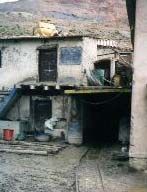 The mud is sticky and slippery; it extends into the mine for the first hundred yards before the ground dries out in pitch darkness. At the mine opening there are some gray adobe buildings used for equipment storage. I peeked into a half open door to see a squat wrinkled woman cooking in a crude kitchen with black kettles over a wood fire–lunch for the miners, I presumed. The warm aromas contrasted with the grueling scene outside.
The mud is sticky and slippery; it extends into the mine for the first hundred yards before the ground dries out in pitch darkness. At the mine opening there are some gray adobe buildings used for equipment storage. I peeked into a half open door to see a squat wrinkled woman cooking in a crude kitchen with black kettles over a wood fire–lunch for the miners, I presumed. The warm aromas contrasted with the grueling scene outside.
We bent our heads forward to accommodate the varying ceiling heights, sometimes only five feet tall. The cold damp air carried a slight sting of smells from the various gases in the minerals, although not unbearable (no one covered their noses).
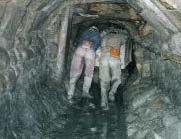 Deeper into the mine daylight disappears completely. Only trudging footsteps are heard for a while as our guide follows the meek beam of his lamp. Occasionally a fork in the pathway diverges into another shaft. We shine a light into it but the blackness swallows the light after twenty feet. Further on another gaping mouth this one leading down to a lower unused channel. Old support logs have collapsed into it.
Deeper into the mine daylight disappears completely. Only trudging footsteps are heard for a while as our guide follows the meek beam of his lamp. Occasionally a fork in the pathway diverges into another shaft. We shine a light into it but the blackness swallows the light after twenty feet. Further on another gaping mouth this one leading down to a lower unused channel. Old support logs have collapsed into it.
This is a lifeless place until we hear the approaching rumble of an ore cart being pushed by miners on their way out. They pause to exchange a few words with the guide, their faces spotlighted by one another’s lamps, like floating heads. I am allowed to take photos and my flash blazes for a second to capture the brown faces and gritty clothes of the men.
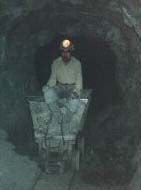 A minute later they are gone and we continue into the ink well. Punched into the darkness of the mountain are hundreds, thousands, of mines that burrow for kilometers. Others are mere crawl holes, remnants of caves built four hundred years ago by the Inca and African slaves.
A minute later they are gone and we continue into the ink well. Punched into the darkness of the mountain are hundreds, thousands, of mines that burrow for kilometers. Others are mere crawl holes, remnants of caves built four hundred years ago by the Inca and African slaves.
More abandoned shafts, weary crooked beams; our guide points out a vein of silver, another of iron, another of tin in this mountainous treasure chest that has made some men wealthy and most others sick. We could walk for hours further into this abyss.
Life Underground
When we reach a slightly widened dig being worked by several men they chat with us for a bit. The conquering Spanish language has never left here. They seem good-natured and banter with the guide about us, wanting to know what country we’re from. They are young and a little older than young.
 Some of these workers in this mountain as young as eight years of age (when school is out). Most of the others are at least 17 years old and by the time they are 27 their lungs are damaged by the mineral dust and gases; their life expectancy is about 40 years. There are no old miners.
Some of these workers in this mountain as young as eight years of age (when school is out). Most of the others are at least 17 years old and by the time they are 27 their lungs are damaged by the mineral dust and gases; their life expectancy is about 40 years. There are no old miners.
Their faces are puffed out on onecheek from the wad of cocoa leaves they chew along with a sip of lemon juice to coax the cocaine-like effects from the plant. It has a soothing effect on these denizens of the dark as they toil for eight to ten hours in the grime of the rocky ore. They dig it from its volcanic bond in the earth, shovel it into iron hoppers and push it along wiggly rails to the sunshine a kilometer or more away.
The leaves soothe them, perhaps to minimize their feelings about living like moles. They were finishing up their shift and playfully offered this softie visitor a ride out in an empty ore cart. I declined as my guide and I headed down another black artery to see El Diablo (or Tio), a rocked carved figure representing the God of the underground, its large face, about two feet tall, wrapped with ribbons and garlanded with herb twigs and some dried corn cobs as offerings.
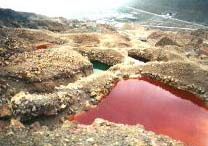 The mine was harrowing. Few outsiders are drawn to trek below ground in their Dockers and Reeboks to come face to face with this arduous, grimy, toxic, subterranean job carried on by men who willingly–but without real choice–sacrifice their health for subsistence pay.
The mine was harrowing. Few outsiders are drawn to trek below ground in their Dockers and Reeboks to come face to face with this arduous, grimy, toxic, subterranean job carried on by men who willingly–but without real choice–sacrifice their health for subsistence pay.
There is not a single tree growing on the entire hill. The ponds are filthy with dark colored seepage from the minerals and tailings. The color of the cone-shaped mount, close up, is mostly red–not an inappropriate color for this miners’ golgotha.
Yet century after century workers still crawl into the holes to dig the dust.
After work the miners change their clothes and shower off they head down the hill to one of the numerous clattering buses that circulate between Serro Rico and various parts of Potosi. We followed our guide down this rocky, pitted and color-streaked slope to catch one of the buses back to town where sunlight warmed the skin and trees, tile roofs and cobbled lanes–back to life.
 Human beings do not belong underground, yet there we were a kilometer inside a dirt hole where many Bolivian men spend their young career years and retire early, often with destroyed lungs. What staggers the mind is that from about 1645 to about 1845, the Spanish pillaged this land of its silver in order to line the coffers of the elite (and more than one bishop)–at a cost of more than eight million lives! If ever there were unacknowledged holocausts, this is one of the greatest.
Human beings do not belong underground, yet there we were a kilometer inside a dirt hole where many Bolivian men spend their young career years and retire early, often with destroyed lungs. What staggers the mind is that from about 1645 to about 1845, the Spanish pillaged this land of its silver in order to line the coffers of the elite (and more than one bishop)–at a cost of more than eight million lives! If ever there were unacknowledged holocausts, this is one of the greatest.
And into these pits present day miners still trek in order to make a living. Of course no one is forced to go down, but when your family has only known this labor as a way of life, is there really a choice?
To touch, however slightly, the dismal life of those who serve in the noxious, claustrophobic spaces earning a few dollars a day, was, for me, both shamefully alluring and anxiety provoking. I knew the historical statistics before the tour. In a few hours of our time we had measured and felt the life of miners, ancient and modern and the harrowing, dismal human toll still being extracted on this rich hill.
Also See:
Gay Bolivia News & Reports 2002 to present
Gay Bolivia Photo Gallery
















